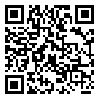Volume 16, Issue 1 (3-2022)
payavard 2022, 16(1): 71-80 |
Back to browse issues page
Ethics code: IR.TUMS.MEDICINEREC.1400.641
Download citation:
BibTeX | RIS | EndNote | Medlars | ProCite | Reference Manager | RefWorks
Send citation to:



BibTeX | RIS | EndNote | Medlars | ProCite | Reference Manager | RefWorks
Send citation to:
Nejat S A R, Bigler M, Kashian S B. Assessing the Maturity of Intellectual Capital in the Field of Management and Planning of Tehran University of Medical Sciences. payavard 2022; 16 (1) :71-80
URL: http://payavard.tums.ac.ir/article-1-7186-en.html
URL: http://payavard.tums.ac.ir/article-1-7186-en.html
1- Assistant Professor, Department of Resource Management, NAJA Institute of Law Enforcement and Social Studies, Tehran, Iran , amir_nejat@yahoo.com
2- Assistant Professor, Department of Medicinal Chemistry, Drug Design and Development Research Center, Institute of Pharmaceutical Sciences, Tehran University of Medical Sciences, Tehran, Iran
3- Master of Science in Industrial Engineering, Vice Chancellor for Management Development and Resource Planning, Tehran University of Medical Sciences, Tehran, Iran
2- Assistant Professor, Department of Medicinal Chemistry, Drug Design and Development Research Center, Institute of Pharmaceutical Sciences, Tehran University of Medical Sciences, Tehran, Iran
3- Master of Science in Industrial Engineering, Vice Chancellor for Management Development and Resource Planning, Tehran University of Medical Sciences, Tehran, Iran
Abstract: (1517 Views)
Background and Aim: Intellectual capital, with its basic knowledge nature, is an intangible, strategic, unique and competitive advantage resource. The purpose of this study is to investigate the current state of intellectual capital maturity in the field of management and planning of Tehran university of medical sciences.
Materials and Methods: This research was applied in terms of purpose and with a quantitative approach in 1400 and a questionnaire was used to collect information. The statistical population is the middle and basic managers of the Vice Chancellor for Resource Management Development and Planning. Using Morgan table, 57 people were randomly selected and analyzed by t-test and non-parametric statistical tests using SPSS software. Has been. The content validity of the questionnaire was obtained by examining the research background and obtaining the opinions of experts, and the Cronbach’s alpha coefficient was used to assess the reliability, the value of which was 0.874.
Results: Statistical tests show that the five levels of intellectual capital management maturity follow a nonlinear pattern and the level of realization of the initial level characteristics, ie lack of intellectual capital structure, is higher than acceptable, but the statistical test of other levels of maturity Included; Managed, defined, quantified and optimal management is not significant at the significance level of 0.05.
Conclusion: The current situation of intellectual capital in the study population indicates that management is unaware of the importance of intellectual capital and no action has been taken to implement the knowledge capital management process. Although there is a lot of necessary infrastructure in the Vice Chancellor, however, insufficient understanding of the capabilities of intellectual capital management as a strategic resource is evident in this research. To reach the defined level and the next levels, the organization needs to identify, activate and direct the intangible source and then quantify, standardize and manage quantitatively and analyze the strengths and weaknesses and finally the continuous improvement of processes and Focus on innovation.
Materials and Methods: This research was applied in terms of purpose and with a quantitative approach in 1400 and a questionnaire was used to collect information. The statistical population is the middle and basic managers of the Vice Chancellor for Resource Management Development and Planning. Using Morgan table, 57 people were randomly selected and analyzed by t-test and non-parametric statistical tests using SPSS software. Has been. The content validity of the questionnaire was obtained by examining the research background and obtaining the opinions of experts, and the Cronbach’s alpha coefficient was used to assess the reliability, the value of which was 0.874.
Results: Statistical tests show that the five levels of intellectual capital management maturity follow a nonlinear pattern and the level of realization of the initial level characteristics, ie lack of intellectual capital structure, is higher than acceptable, but the statistical test of other levels of maturity Included; Managed, defined, quantified and optimal management is not significant at the significance level of 0.05.
Conclusion: The current situation of intellectual capital in the study population indicates that management is unaware of the importance of intellectual capital and no action has been taken to implement the knowledge capital management process. Although there is a lot of necessary infrastructure in the Vice Chancellor, however, insufficient understanding of the capabilities of intellectual capital management as a strategic resource is evident in this research. To reach the defined level and the next levels, the organization needs to identify, activate and direct the intangible source and then quantify, standardize and manage quantitatively and analyze the strengths and weaknesses and finally the continuous improvement of processes and Focus on innovation.
Keywords: Intellectual Capital, Organizational Maturity Model, Tehran University of Medical Sciences
Send email to the article author
| Rights and permissions | |
 |
This work is licensed under a Creative Commons Attribution-NonCommercial 4.0 International License. |






